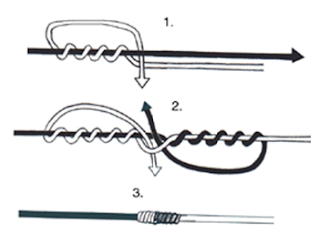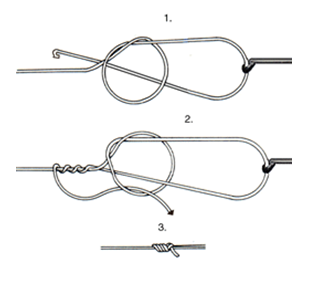Fly Fishing Knots
There are many different knots that you can use to tie your fly lines. Any one of them will work just fine. Which one you choose is a matter of personal preference. It is essential that you simply tie the knot correctly and secure it properly. Failing to accomplish so will outcome in lost fish as well as a large amount of aggravation.
Before you tighten a knot, you should wet it either with saliva or by dipping it in water. This will likely help the knot slide and seat properly. Lubrication also decreases excessive heat which drastically weakens monofilament. Heat is generated by the friction designed when knots are drawn up tight.
Seating the knot implies to tie it tightly. Tighten knots with a steady, continuous pull. Make certain the knot is tight and secure. Soon after it's tied, pull on the line and leader to make sure it holds. It's far better to test it now than when a fish is on.
You may also need to trim the ends neatly. Use nippers to trim the material as close as possible without nicking or damaging the knot.
Right here are several of the more typical knots for Fly Fishing you can try:
These are only a number of from the knots you can use to tie your fly line. Ask other people what they favor and learn from your fishing buddies if you'd like. You'll find all sorts of knots and no one is far better than an additional. As we’ve stated, it is a matter of personal preference!
Before you tighten a knot, you should wet it either with saliva or by dipping it in water. This will likely help the knot slide and seat properly. Lubrication also decreases excessive heat which drastically weakens monofilament. Heat is generated by the friction designed when knots are drawn up tight.
Seating the knot implies to tie it tightly. Tighten knots with a steady, continuous pull. Make certain the knot is tight and secure. Soon after it's tied, pull on the line and leader to make sure it holds. It's far better to test it now than when a fish is on.
You may also need to trim the ends neatly. Use nippers to trim the material as close as possible without nicking or damaging the knot.
Right here are several of the more typical knots for Fly Fishing you can try:
Albright
The Albright knot is used in situations exactly where you need to join two lines of drastically unequal diameter or of different material. Mainly used in saltwater situations, you can also use this knot for joining of fly line to backing material.- Loop the heavier line (wider diameter) and location it between your thumb and index finger of the left hand. Pass the lighter line through the formed loop leaving about 8 inches. Pinch the lighter line in using the line already in your left hand. (See illustration 1)
- Make approximately ten wraps using the lighter line wrapping away from you and working from left to right. With each wrap, work your thumb and index finger along holding these wraps in place, trying to not let up any pressure on your left hand. On the 10th wrap, come around and after that through the remaining loop.
- Take the standing line inside your right hand and pull gently as you push the wraps together with your left hand towards the closed loop. Alternate between the end on the lighter line and on the standing element until the wraps are against the tag end. Make sure the wraps usually do not go over each other and that you don't push them to far. Pull the tag tight then pull on the standing portion of both lines till the knot is secure.
- Ultimately, clip the two quick pieces close for the knot.
Arbor Knot (Backing To Reel)
- Wrap the line around the arbor of one's spool and tie an overhand knot around the standing line.
- Tie a second overhand knot around the tag end a number of inches in the first.
- Moisten the line as well as the two overhand knots. Tighten the smaller knot and holding the spool in your left-hand pull on the standing line along with your right hand sliding the initial overhand knot against the arbor of the spool. The second overhand knot will keep this from slipping. Trim the tag end.
Blood Knot (Monofilament to Monofilament)
The blood knot is really a knot used for attaching two pieces of monofilament with each other, primarily for rebuilding tapered leaders. This really is an extremely strong knot when formed properly and ought to be tied with monofilament close in diameter. Best use is for monofilament 10 lbs. and up.- Lay both sections of monofilament across one another. Wrap one section 5-6 times around the other bringing the end back down through the loop formed by both. (See illustration 1)
- Wrap the other line 5-6 times around the remaining portion in the very first line and pass it really is cost-free end up through the formed loop. (See illustration 2)
- Moisten the knot along with your mouth, and while holding the long ends pull the knot tight. Clip the brief ends close as well as the knot is complete.
Turle Knot
The Turle knot is ideal when tying on flies with turned-up or turned-down eyes to your leader. This offers your fly good action because of the way the knot causes the leader to pull away from the hook. It may be tied with one or two wraps of an overhand knot.- Pass the leader end through the hook-eye. Take two wraps around the standing line and pass the tag end through the loops forming a straightforward overhand knot. Tighten it down.
- Pass the fly through the large loop formed and snug it against the hook-eye.
- Tighten down and trim off the excess.
Improved Clinch Knot (Leader to Fly)
The Improved Clinch knot is used for fastening the leader for the fly. In the event you are making use of over 12 Lb. test line, this is not a advisable knot.- Thread your leader tippet through the eye from the hook. Wrap the end of the leader around the standing line 5 times for lines as much as 8lb test and four times for lines from 8-12lb test. (You can also turn the hook five or 4 times)
- Take the tag end in the leader and pass it through the gap between the eye from the hook as well as the 1st wrap. Continue the tag end back up through the key loop just formed.
- Moisten the knot with your mouth, and while holding the hook in your left-hand pull on the standing leader permitting the knot to seat tightly against the hook. Clip the excess line.
Non-Slip Mono Knot
The Non-Slip Mono Knot is extremely strong and because the name says, does mot slip like some of the other loop knots. This knot has been tested to close to 100% on the line strength. It is very important that you just stick to the wrap counts for maximizing its strength. 8X to 6lb test: 7 wraps. eight to 12lbs: five wraps. 15lb to 40lb test: four wraps. 50-60lb test: 3 wraps, and up to 120lb test: two wraps.- Take your line and form an over-hand knot, leaving approximately eight inches. Pass the tag end through the eye in the hook. Bring the line back through the overhand knot precisely the same side it came out. Make your wraps based upon the numbers above.
- Right after all the wraps are completed pass the line back through the more than hand knot the same way it came out inside the final step.
- Moisten the knot with your mouth, and while holding the hook inside your right-hand pull slowly. As the knot tightens, take the standing line in your left hand and pull your hands apart finishing the knot. Ultimately, trim the ends.
Perfection Loop
The perfection loop knot is used for attaching two looped pieces of monofilament with each other. Often used for a rapid change of leaders. This is a reliable and strong when formed properly.- Take the standing line within your left hand and form a loop by crossing the tag end more than itself together with your right hand. Pinch between the thumb and index finger inside your left hand exactly where it crosses leaving about 5 inches in the tag end exposed to work with. Form a smaller loop in front from the larger loop by bringing the tag end in front on the first formed loop. Pinch this in using the first crossover.
- Take the tag end, wrapping it around the back of both loops and then between the two loops. Soon after you go amongst both loops add that to what you might be pinching down between your fingers.
- Together with your right hand, reach through the first formed loop taking the second smaller loop between your thumb and index finger and pulls it through the very first loop. Moisten and gradually pull on the standing line continuing to hold the smaller loop which you pulled through. Trim the tag end close as well as the loop knot is complete.
Surgeon’s Knot
The Surgeon's Knot is really a knot also used for attaching two pieces of monofilament collectively. It truly is an extremely fast and easy knot to tie and is usually preferred more than the blood knot. That is a great knot for joining two pieces of monofilament which might be tremendously different in diameter. When you find yourself building a tapered leader, tied appropriately, this knot is normally stronger than the blood knot. This can be a extremely rapid and easy knot for attaching 4X-5X-6X-7X tippet to each other. You can do that one in the dark.- The primary line ought to come in from the left and the line to be attached should come from the right. Overlap the two pieces approximately six or so inches. (See illustration 1)
- Pinch the overlapped lines together on the left between your thumb and index finger. Do exactly the same together with the sections on the right and make a loop by crossing it more than itself. Take the long and brief lines which might be in your right hand and pass them through the formed loop, around, and back through a second time. (See illustration two)
- Pull both pieces getting held in each hand away from each other closing the knot. Moisten and pull tight. As soon as this not is secure you can tighten it further by pulling individual pieces. I'd not suggest this knot for line over 30lbs because it will be difficult to tighten along with the strength on the knot will only be there if tightened all the way.
These are only a number of from the knots you can use to tie your fly line. Ask other people what they favor and learn from your fishing buddies if you'd like. You'll find all sorts of knots and no one is far better than an additional. As we’ve stated, it is a matter of personal preference!







